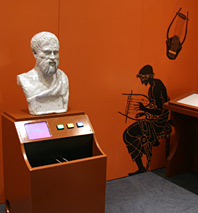
A proper accounting of ancient Greece is not kid stuff. Hellenic history and mythology are awash in bloody war (did you see 300?), adulterous deities, and horrifying-by-modern-standards behavior. So, as project director Karen Snider and her team at the Children’s Museum of Manhattan put together the $1.6 million exhibit “Gods, Myths and Mortals,” they took special care—plus lots of focus-group testing of fifth- and sixth-graders, who are going through their ancient-history units in school—as they decided what to feature, what to play down (the charms of the Sirens, full-frontal nudity), and what to avoid altogether (adultery, murder). “War and conflict were a fact of life in the ancient world, so we can’t avoid it,” says Snider. “But we’re not delving into the details.” So what remains? Kids take to the path of Homer’s Odyssey, starting with an escape-the-Cyclops field filled with life-size fuzzy sheep. At the Sirens Karaoke Cove, Snider expects family tugs-of-war over who gets to sing “We Will Rock You” into a mike that modulates any voice to a Betty Boop pitch. And visitors will rid Odysseus’ palace of unwanted suitors through a wall-mounted game of Whac-a-Mole. For science-minded youngsters, the exhibit continues with a model of the Antikythera Mechanism, a mysterious 2,000-year-old bit of scientific machinery that is believed to have tracked planetary movement, serving as an early MapQuest for mariners. “It may not be so interesting for a 6-year-old,” says Xenophon Moussas, a Greek astrophysicist who consulted on this part of the exhibit. “But for older children, the headline is ‘Greece: Where Science Began.’”
Exhibit opens 5/25 and runs through early September 2008; Children’s Museum of Manhattan, 212 W. 83rd St., nr. Broadway (212-721-1223 or cmom.org); $9 grown-ups and kids, $6 seniors, free for infants.